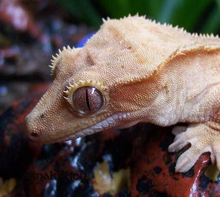New Caledonian Crested Gecko
| Crested Gecko | |
|---|---|
 |
|
| Scientific classification | |
| Kingdom: | Animalia |
| Phylum: | Chordata |
| Class: | Reptilia |
| Order: | Squamata |
| Family: | Diplodactylidae |
| Genus: | Correlophus |
| Species: | C. ciliatus |
| Binomial name | |
|
Correlophus ciliatus Guichenot, 1866 |
|
 |
|
| Approximate distribution of the crested gecko | |
| Synonyms | |
|
|
The crested gecko, New Caledonian crested gecko, Guichenot's giant gecko or eyelash gecko (Correlophus ciliatus) is a species of gecko native to southern New Caledonia. In 1866, when New Caledonia was discovered, the crested gecko was discovered by a French zoologist named Alphone Guichenot who is also credited with naming the species. This species was thought extinct until it was rediscovered in 1994. Along with several Rhacodactylus species, it is being considered for protected status by the Convention on the International Trade in Endangered Species of Wild Flora and Fauna. It is popular in the pet trade.
The species was first described in 1866 as Correlophus ciliatus by the French zoologist Alphone Guichenot in an article entitled "Notice sur un nouveau genre de sauriens de la famille des geckotiens du Muséum de Paris" ("Notes on a new species of lizard in the gecko family") in the Mémoires de la Société Scientifique Naturelle de Chérbourg. It was later renamed Rhacodactylus ciliatus. Recent phylogenetic analysis indicates that R. ciliatus and R. sarasinorum are not closely related to the other giant geckos, so these two species have been moved back to the genus Correlophus.
The specific name, ciliatus, is Latin: cilia means "fringe" or "eyelashes" and refers to the crest of skin over the animal's eyes that resembles eyelashes.
The crested gecko has hair-like projections found above the eyes, resembling eyelashes. It has a wedge-shaped head and a crest that runs from each eye to the tail. Crested geckos do not have eyelids and so they use their long tongues to moisten their eyes and remove debris. The toes and the tip of the semi-prehensile tail are covered in small hairs called setae. Each seta is divided into hundreds of smaller (approximately 200 nanometres in diameter) hairs called spatulae. It is believed these structures exploit the weak van der Waals force to help the gecko climb on most solid surfaces. The toes have small claws which aid in climbing surfaces to which their toes cannot cling. They possess a semi-prehensile tail which they use to assist in climbing. The tail can be dropped as a deterrent to predators. Unlike some other geckos, once they lose their tail it will not grow back; however, this is not as harmful to the gecko as it is in other species, such as the Leopard gecko. In fact, most adults in the wild lack tails.
...
Wikipedia

